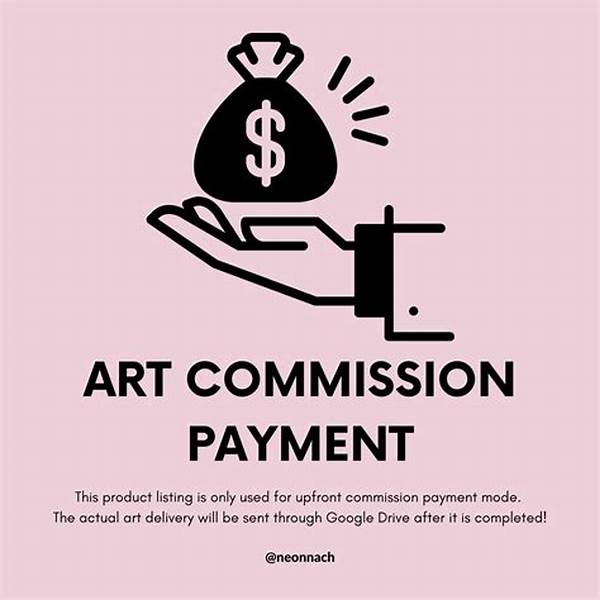Understanding the nuances of payment terms in the realm of art commissions is crucial for both artists and clients. Not only does it ensure a smooth transaction, but it also preserves the integrity of the professional relationship. This article delves into the key aspects of art commission payment terms and provides insights into managing them effectively.
Read Now : Theatrical Lighting And Sound Design
Importance of Clear Art Commission Payment Terms
Having clear art commission payment terms is essential for preventing misunderstandings. They act as a binding agreement between the artist and client, detailing when and how payments should be made. This clarity enhances trust and ensures that both parties have a mutual understanding of the transaction. Artists can avoid potential issues such as late payments or modifications in the payment structure, while clients are assured of what they are paying for and when. In essence, clear payment terms protect the rights and expectations of both artists and clients, facilitating a professional and respectful relationship.
Furthermore, art commission payment terms often include deposits, milestone payments, or final payments. Each of these serves to break down the payment process into manageable parts, offering a sense of security for both sides. For instance, a deposit signals a client’s commitment to the project, while milestone payments ensure that the artist is consistently compensated for ongoing work. This structured approach not only safeguards the interests of both parties but also encourages artists to maintain high standards of work throughout the project.
Key Components of Art Commission Payment Terms
1. Deposits: A non-refundable deposit can secure a commission and demonstrate trust between artist and client. It typically ranges from 20% to 50% of the total fee.
2. Milestone Payments: These are payments distributed at various stages of the project’s completion, ensuring the artist receives compensation as the work progresses.
3. Final Payment: This is the balance due upon the completion and approval of the commission, finalizing the transaction and transferring ownership rights, if applicable.
4. Payment Methods: Clear indication of accepted payment forms, such as bank transfers, PayPal, or credit cards, should be outlined to avoid confusion.
5. Late Payment Fees: Specifying fees for late payments can ensure timely transactions and communicate the seriousness of honoring payment schedules.
Structuring Art Commission Payment Terms
Establishing effective art commission payment terms requires careful consideration and open communication. Both parties need to agree on every detail to ensure a smooth transaction. Initial discussions should cover the scope of work, deadlines, fees, and preferred payment methods. This process not only sets expectations but also minimizes the risks of disputes later on.
Artists are encouraged to maintain professionalism and transparency throughout the commissioning process. Clearly documented agreements help safeguard the artistic journey from start to finish. Clients, on the other hand, should be clear about their requirements and budget constraints. By treating art commission payment terms as a priority, both artists and clients can focus on the creative aspects of the project, ensuring satisfaction on both sides.
Best Practices for Art Commission Payment Terms
1. Clear Communication: Always discuss and document payment terms before starting a project.
2. Documentation: Formalize agreements in writing for transparency and legal security.
3. Flexibility: Allow room for negotiation if unexpected challenges arise, but maintain a firm stance on agreed terms.
4. Regular Updates: Provide progress reports to assure the client of work development and justify milestone payments.
5. Respect Deadlines: Adhering to agreed timelines ensures project satisfaction and encourages ongoing collaboration.
Read Now : Internet-based Group Drawing Tools
6. Accurate Invoicing: Provide detailed invoices that match agreed-upon payment terms and stages of work.
7. Clarity in Pricing: Outline all costs upfront, including potential adjustments due to client requests.
8. Ensure Mutual Benefits: Establish terms that benefit both parties equally, fostering trust and respect.
9. Professionalism: Maintain a professional demeanor, which further solidifies the relationship.
10. Understanding Legalities: Be aware of legal obligations regarding contracts and payments in your jurisdiction.
Negotiating Art Commission Payment Terms
Negotiating art commission payment terms requires a balance of assertiveness and empathy. Both parties must voice their needs and limitations clearly while remaining open to compromise. Artists typically draft initial terms based on industry standards and their preferred practices, while clients may have specific requirements.
Open dialogue during negotiation is essential. It’s beneficial for both parties to have a clear understanding of the project’s scope, timeline, and budget. By discussing these elements openly, the final payment terms are likely to reflect a well-considered agreement. Moreover, professional courtesy and a genuine understanding of each other’s expectations contribute to a harmonious negotiation process. This not only paves the way for a successful commission but also establishes a foundation for potential future collaborations.
Challenges in Art Commission Payment Terms
Even with well-defined art commission payment terms, challenges may arise. Unforeseen delays, changes in artistic direction, or financial constraints can complicate the payment structure. Both artists and clients must be prepared to address these situations with flexibility and a problem-solving mindset.
For artists, maintaining detailed records of work progress and communication ensures they have a clear account of the project’s history. For clients, timely and open communication can help address concerns early, preventing escalation. By addressing challenges proactively and collaboratively, both parties can uphold the integrity of the payment terms and preserve their professional relationship.
Summary of Art Commission Payment Terms
In summary, art commission payment terms are a vital component of commissioning artwork. They not only define the financial parameters of the project but also set the tone for the professional relationship between the artist and the client. By clearly outlining expectations regarding deposits, milestone payments, final payments, payment methods, and late payment fees, both parties can engage in a harmonious transaction.
To ensure success, it is crucial to implement best practices such as maintaining clear communication, providing regular updates, and respecting deadlines. These ensure that the creative process remains uninterrupted and focused. Furthermore, being flexible and prepared to handle unexpected challenges strengthens the resolve to adhere to pre-agreed payment terms. In essence, effective art commission payment terms encapsulate the balance between creativity and professionalism, ultimately enhancing the experience for both artists and clients.



